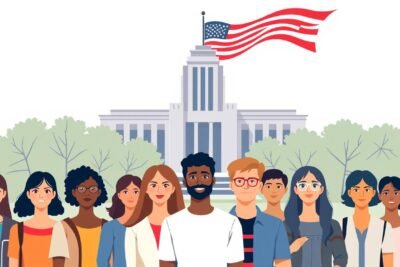
Federal Loan Forgiveness for Healthcare Workers: Your Guide

You finish a long shift, pick up a note about another bill, and wonder how to make the math work. A friend from residency told me she had $220,000 in student debt and felt stuck. She found a path by asking simple questions and matching her job to the right program.
This guide gives a clear, friendly walkthrough of the options for people in patient care who face heavy student debt. You’ll learn when Public Service can help, how income-driven plans work, and where employer repayment can fill gaps.
Expect simple steps to check employer eligibility, certify employment, and track payments so you protect your path to relief. For facts and deeper data on average balances and program choices, visit studyfinance.org.
By the end of this article you’ll know how to compare programs, spot tax issues, and build a plan that fits your career and budget.
- How federal loan forgiveness healthcare workers programs work today
- Decide your best path: nonprofit service, underserved areas, research, or private practice
- Public Service Loan Forgiveness for healthcare workers
- Income-Driven Repayment forgiveness and payment planning
- National Health Service Corps and other federal loan repayment programs
- State-based loan repayment and public service opportunities
- Verify eligibility and prepare your documents
- Apply with confidence: timelines, portals, and follow-through
- Optimize while you wait: strategies to lower costs and stay eligible
- Your next move toward a lighter student loan burden
How federal loan forgiveness healthcare workers programs work today
Start simple: some paths erase your remaining balance after set service or time, while others pay parts of your debt as you serve.

What each approach means
Forgiveness eliminates the remaining balance once you meet criteria like 120 qualifying payments or long-term income-based schedules. That outcome can wipe out years of payments.
Repayment assistance gives cash awards toward your balance in return for service commitments. Examples include NHSC, IHS, Nurse Corps, NIH LRPs, and the VA EDRP.
Quick landscape: PSLF, IDR, and LRPs
PSLF forgives Direct Loans after 120 qualifying payments while you work full time for a qualifying nonprofit or government employer. That forgiveness is tax-free at the federal level.
IDR plans cap monthly amounts (about 5%–20% of discretionary income) and offer forgiveness after 20–25 years; tax rules may change after 2025.
- LRPs pay set awards NHSC ($50k–$75k), IHS ($50k), Nurse Corps (up to 85% of debt), NIH (up to $50k/year), VA EDRP (up to $200k).
- Only Direct Loans count for PSLF; consolidation can fix ineligible loan types.
Do a quick audit of your employer type, loan status, and repayment plan to see which path fits your role, location, and timeline.
Decide your best path: nonprofit service, underserved areas, research, or private practice
Choosing a track starts with where you want to work and how fast you want debt relief. Match your specialty and mobility to a program that fits your life and career goals.

Quick fit check: PSLF for public service roles
PSLF-style routes suit government and 501(c)(3) nonprofit employers, including public hospitals and clinics. You can combine part-time roles so long as total hours reach 30 per week.
When LRPs (NHSC, IHS, Nurse Corps, VA) make more sense
LRPs reward service in shortage areas or research posts with set awards. They often require multi-year commitments and may be taxable. If you want guaranteed payments tied to location, LRPs can beat long waits.
If you’re in private practice: IDR forgiveness or refinancing
Income-driven repayment keeps monthly costs low and leads to forgiveness after years of qualifying payments. If you expect high, steady income and don’t rely on student loan forgiveness, refinancing with a private lender can cut interest.
- Decide fast: PSLF for nonprofit government roles; LRPs for shortage sites; research LRPs for scientists; IDR/refinance for private practice.
- Plan A/Plan B: stack programs when possible and check tax effects.
Public Service Loan Forgiveness for healthcare workers
Start by checking employer eligibility, then confirm your loans and payments to build a reliable path to discharge.

- You work for a government or 501(c)(3) employer, or you combine part-time roles to reach a full-time qualifying total of 30+ hours weekly.
- Your loans are Direct Loans, or you consolidate FFEL/Perkins into Direct Loans to qualify without losing credited periods under the IDR Account Adjustment.
- You make 120 qualifying payments while on a qualifying repayment plan, typically an income-driven repayment plan that keeps payments predictable.
Using the PSLF Help Tool and certifying employment
Use the PSLF Help Tool to confirm employer eligibility and generate the employment certification form. Submit this form annually to MOHELA or the Department of Education to protect your payment counts.
Getting credit toward the 120 qualifying payments
Track your qualifying payments closely. The IDR Account Adjustment (completed Jan 2025) updated many past months, and some forbearance or deferment periods may now count.
"Certify every year and keep your own records servicer counts can vary, and your files settle disputes fast."
| Requirement | What to check | Tip |
|---|---|---|
| Employer type | Government or 501(c)(3) nonprofit | Use the PSLF Help Tool to confirm |
| Loan type | Direct Loans (consolidate if needed) | Consolidation can preserve IDR Account Adjustment credits |
| Payments | 120 qualifying, on an IDR or qualifying repayment plan | Track dates and certify employment annually |
Next steps: Keep records of pay dates and certifications, avoid long forbearance spells, and submit the PSLF application once you hit 120 qualifying payments. If you change careers, plan a backup path such as IDR forgiveness and review guidance on navigating repayment system.
Income-Driven Repayment forgiveness and payment planning
Income-driven repayment can make your monthly budget work while you chip away at a large student debt balance. Pick the plan that lowers payments most based on your income, family size, and loan type.
How payments are set: IDR plans like SAVE, PAYE, and IBR set payments at roughly 5%–20% of discretionary income. SAVE adds a 225% poverty-line deduction that can cut payments further. $0 payments during qualifying periods still count toward repayment forgiveness.
Timelines and tax risks: Expect 20–25 years to final discharge depending on plan and loans. After Dec 31, 2025, forgiven balances may be taxable; consider saving a small percentage each year to cover potential tax on your remaining loan balance.
"Recertify income every year, track IDR Account Adjustment credits, and update your payoff timeline when your circumstances change."
| Topic | What it means | Action |
|---|---|---|
| Plan choice | Pick SAVE, PAYE, or IBR for lowest payments | Run estimates with current income and family size |
| SAVE status | 225% poverty-line deduction; litigation ongoing | Monitor updates and keep backups like IDR recertification |
| Taxes | Forgiven balance may be taxable after 2025 | Set aside funds annually (small percent of payment) |
Use IDR as a flexible plan B if your PSLF route shifts. For broader guidance on managing the repayment system, see navigating the repayment system.
National Health Service Corps and other federal loan repayment programs
If you want fast, targeted repayment help, several service-based programs pay large sums in exchange for your commitment.
NHSC LRPs offer tiered awards to clinicians who work at HPSA sites. Full-time two-year commitments can yield up to $50,000, or $75,000 for primary care. Half-time options pay $25,000 or $37,500. A $5,000 bonus may apply for Spanish proficiency. NHSC also runs SUD and Rural Community tracks for behavioral health and rural practice.
Indian Health Service option
The IHS LRP pays $50,000 for a two-year term serving American Indian or Alaska Native communities. You can extend annually to keep reducing your balance. This program is a strong fit if your practice aligns with tribal health needs.
Nurse Corps and NIH opportunities
Nurse Corps covers up to 60% of nursing education debt over two years, plus 25% in a third year for eligible RNs, APRNs, and nurse faculty. Benefits may be taxable, so plan accordingly.
NIH LRPs provide up to $50,000 per year for qualified researchers, both intramural and extramural. This is attractive if you want research funding that directly offsets student loan balances.
VA EDRP at a glance
VA EDRP can deliver up to $200,000 over five years for qualifying VA roles. If you consider a VA career, this program can substantially change your repayment timeline.
"Assess eligibility, time your applications, and plan for taxes so you keep the most benefit."
| Program | Typical award | Term / Notes |
|---|---|---|
| NHSC LRP | $25k–$75k | 2-year full/half-time; HPSA sites; SUD & Rural tracks |
| IHS LRP | $50,000 | 2-year term; renewable annually for tribal communities |
| Nurse Corps | 60% + 25% | 2 years + optional 3rd year; RN/APRN/faculty eligible; may be taxable |
| NIH LRP | Up to $50,000/yr | For qualified researchers; intramural & extramural |
| VA EDRP | Up to $200,000 | Over 5 years for qualifying VA positions |
- Check site HPSA scores and award tiers to target the best match.
- Map application cycles and required documents to avoid missed windows.
- Consider stacking service corps repayment with PSLF by choosing qualifying employers.
State-based loan repayment and public service opportunities
If you want fast reductions in your student loan balance, start with your state health department and shortage-area programs.
Many states offer repayment programs that reward service in high-need areas. Pennsylvania’s Primary Care Loan Repayment Program, for example, can provide up to $80,000 for physicians, dentists, and psychologists over two years. Other practitioners may see $48,000 (full-time) or $24,000 (half-time).
Where to look: state health departments and shortage area programs
Begin at your state health department or primary care office to find current openings, deadlines, and award tiers. Programs vary by state New Mexico, Iowa, and Alaska’s SHARP plan all use different eligibility rules and scoring systems.
Typical commitments, award ranges, and stacking with PSLF
Most state programs require two- to three-year commitments. Awards often depend on rural versus urban shortage scores and on your specialty and licensure.
"Compare service commitments to award amounts to estimate your effective hourly benefit."
- Check whether the site employer is PSLF-eligible so you can stack state benefits with public service progress.
- Plan application timing around job start dates and gather service verification documents early.
- Confirm state and federal tax treatment; some awards may be taxable.
| State / Program | Typical award | Common term |
|---|---|---|
| Pennsylvania Primary Care | Up to $80,000 (physicians/dentists/psychologists) | 2 years |
| Alaska SHARP | Varied tiers based on specialty and location | 2–3 years |
| New Mexico / Iowa LRPs | State-specific amounts; priority for high-shortage sites | 2 years typical |
Next steps: build a state/federal benefits matrix to decide where your time yields the largest reduction in your student loans, and keep documentation organized for renewals or stacking with PSLF.
Verify eligibility and prepare your documents
A clean file of employment records and payment history makes tracking progress toward relief far easier.
First, confirm employer status with the PSLF Help Tool. That tool tells you whether your employer counts as a nonprofit government or other qualifying site.
Only Direct Loans qualify for PSLF. If you have FFEL or Perkins, plan a consolidation to Direct so your payments will count.
Confirm employer eligibility and loan types
Verify that part-time roles combine to meet minimum hours when applicable. Save the PSLF Help Tool output and employer verification PDFs.
Inventory your accounts and label non-Direct types. Consolidate strategically to avoid losing credited months where possible.
Employment certification, service contracts, and payment records
Download, complete, and submit employment certification forms annually for PSLF tracking. Keep one copy for your records.
Store service contracts, award letters, and site approvals for NHSC, IHS, Nurse Corps, NIH, and VA programs. These prove service for any repayment program or repayment assistance you use.
"Verify your updated counts on after the IDR Account Adjustment and raise discrepancies quickly."
- Keep a log of payment amounts, dates, and plan type to reconcile with servicer records.
- Set annual calendar reminders for IDR recertification and PSLF certification.
- Prepare ID verification, licenses, CVs, and tax documents commonly required for service awards.
- Create a secure digital folder system for contracts, award letters, pay stubs, and certification PDFs.
| Document | Why it matters | Where to store | Action |
|---|---|---|---|
| Employer certification | Proves qualifying work for PSLF | Secure cloud folder + local backup | Submit annually; save confirmation |
| Service contracts / award letters | Required for LRPs and stacking | Encrypted folder with dated filenames | Scan and save originals; record start/end dates |
| Payment log | Reconcile servicer counts and IDR credits | Spreadsheet in cloud and PDF snapshots | Update monthly; note plan changes |
| Tax & ID docs | Needed for applications and taxable awards | Tax folder + encrypted ID files | Keep 3–7 years; consult tax advisor if needed |
Apply with confidence: timelines, portals, and follow-through
Apply with confidence by building a calendar of deadlines, portal logins, and clear paperwork routines.
PSLF applications and annual recertification cadence
Use the PSLF Help Tool to certify employers and save each confirmation. After you hit 120 qualifying payments, submit the PSLF application and keep a copy.
Certify employment every year to protect your counts. Stay on an IDR repayment plan while pursuing public service to preserve credit toward loan forgiveness.
Submitting NHSC, IHS, Nurse Corps, NIH, and VA applications
Each program has its own portal and deadlines. Prepare proof of licensure, site approval, and debt documents before windows open.
Submit early, follow checklist items exactly, and get employer signatures well before deadlines to avoid delays.
Tracking decisions and maintaining compliance during service
Monitor status portals and respond fast to requests. Keep records of hours, site location, and scope of practice to protect awards.
"Keep copies of every submission and escalate discrepancies in writing with dates and contacts."
- Map your year with IDR recertification and PSLF certification reminders.
- Confirm HR contacts, collect signatures early, and archive decision letters.
- Plan tax withholding if awards are taxable and set money aside.
Optimize while you wait: strategies to lower costs and stay eligible
Small changes to payment plans and paperwork can save you money and protect qualifying months.
Choosing the right repayment plan
Pick a plan that fits your cash flow
Choose an income-driven repayment plan that keeps payments low and preserves eligibility for loan forgiveness and loan repayment programs. SAVE offers a 225% poverty-line deduction and lower rates by degree mix, but it is in administrative forbearance while policies are sorted.
Budget, document, and avoid forbearance traps
Keep pay stubs, W-2s, tax returns, and payment histories in one secure folder. Set calendar reminders for income recertification so your plan does not change unexpectedly.
Avoid long forbearance: extended breaks can hurt progress unless past adjustments credit months. If you need relief, $0 IDR months can still count toward forgiveness.
When refinancing helps and when it hurts
Refinance private student balances only if you have high, steady income and don’t rely on PSLF or IDR paths. Private refinancing can lower interest but removes federal protections and repayment assistance options.
"Keep emergency savings and revisit your plan yearly to protect your remaining loan balance and long-term goals."
- Coordinate with HR to use employer repayment assistance without risking eligibility.
- Set aside tax reserves for possible taxable awards or forgiven balances.
- Review your strategy after promotions, fellowship ends, or job moves.
Your next move toward a lighter student loan burden
You can move from overwhelm to control by choosing a main strategy and setting short milestones.
Pick a primary path PSLF for public service roles, an LRP tied to shortage sites, or an IDR plan — and set three 12‑month milestones. PSLF offers tax‑free relief after ten years of qualifying work and payments. IDR plans forgive remaining balance after 20–25 years, though tax rules may shift after 2025.
Run your employer through the PSLF Help Tool, consolidate to Direct Loans if needed, and pick an IDR plan that fits your cash flow. Shortlist 1–2 LRPs or state programs that match your specialty and gather documents now.
Ask HR about employer repayment assistance and sign‑on benefits. Create a simple tracking sheet for payments, certifications, and service dates, and set quarterly reviews to adapt as your income or location changes.
Final step: act on one item this week certify employment, set a recert reminder, or file an LRP application so you keep momentum toward meaningful student loan forgiveness and faster loan repayment.
If you want to know other articles similar to Federal Loan Forgiveness for Healthcare Workers: Your Guide you can visit the category Federal.




Leave a Reply